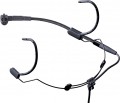Frequency range
The range of audio frequencies normally perceived and processed by a microphone.
The wider this range — the fuller the signal, the less likely that too high or low frequencies will be missed due to the imperfection of the microphone. However, in this case, it is worth considering some nuances. First of all: a wide frequency range in itself does not guarantee high sound quality — a lot also depends on the type of microphone (see above) and its frequency response, not to mention the quality of other components of the audio system. In addition, a large width is also not always really necessary. For example, for normal transmission of human speech, a range of 500 Hz — 2 kHz is considered sufficient, which is much narrower than the general range perceived by the human ear. This general range, in turn, averages from 16 Hz to 22 kHz, and also narrows with age. Do not forget about the features of the equipment to which the microphone is connected: it is hardly worth specifically looking for a model with an extensive range, if, for example, the amplifier to which it is planned to be connected severely “cuts off” the frequencies from above and/or below.
Signal to noise ratio
A parameter that describes the relationship between the useful signal level and the noise level produced by the microphone. Note that the actual signal-to-noise ratio varies depending on the sound pressure perceived by the microphone. Therefore, in the characteristics it is customary to indicate the option for a standard situation — at a sound pressure of 94 dB. This allows you to compare different models with each other.
In general, this indicator quite clearly characterizes the quality of work of a particular model, since it takes into account almost all significant extraneous noise that occurs during operation. The greater this ratio, the clearer the sound is, the less distortion it has. Values of 64 – 66 dB are considered quite decent, and high-end microphones provide performance of 72 dB and higher.
Cable length
This parameter directly affects the freedom of movement and ease of use: the farther the microphone can be taken from the connection point, the more convenient it is, especially when used in large spaces.

